Scientific Research on Maharishi's Transcendental Meditation
Introduction and Overview of Research
Transcendental Meditation was founded by Maharishi Mahesh Yogi in 1957, and was first taught in Great Britain in 1960. Over four million people around the world have learned Transcendental Meditation (160,000 in Britain), and the first published research on this technique appeared in 1970. In 1980 Maharishi introduced Maharishi Ayur-Veda, a thorough and comprehensive revival of the world’s most ancient system of health care.
Maharishi’s Vedic Approach to Health is the name given to the integrated system of health care that includes both Transcendental Meditation and Maharishi Ayur-Veda, as parts of a spectrum of approaches to improving health and well-being.
This section summarizes results of scientific research on Transcendental Meditation, with special emphasis on the area of health. The Scientific Research on Maharishi Ayur-Veda page summaries scientific research specifically in health care approaches.
INTRODUCTION
Transcendental Meditation, as taught by Maharishi Mahesh Yogi, is a simple technique which has well-documented benefits for health, well-being, and performance [1, 2].
Transcendental Meditation is practised for 15-20 minutes twice daily, sitting comfortably with eyes closed. It can be easily learned by anyone regardless of age, educational background, or culture. The technique is effortless and requires no belief nor any change in life-style or diet.
Transcendental Meditation has been taught extensively around the world over the past 40 years. Instruction involves a standard seven-step course given by qualified teachers who have undergone an extensive and systematic training programme, ensuring high professional standards worldwide.
Many British doctors have learned the technique and recommend it to their patients. In a number of cases the National Health Service has paid for instruction in Transcendental Meditation where it has been recommended by a doctor. Transcendental Meditation has many applications in the field of health, and supports the highest ideals of modern health care. Transcendental Meditation teachers, however, do not replace the services of a doctor in any way and always advise people to follow the recommendations of their doctor on health matters.
Research on Transcendental Meditation has been conducted at more than 200 universities, hospitals, and research institutions in 27 countries. As a result, more than 500 research and review papers have been written covering a wide variety of physiological, psychological, and sociological effects. These have been collected in six volumes of research papers, of which over 150 are reprinted from scientific journals [1].
Transcendental Meditation allows mental activity to settle down in a natural way while alertness is maintained and indeed enhanced. Following Transcendental Meditation, individuals report feeling refreshed physically and mentally. The mind is calmer and more alert, thinking is clearer, and energy levels are increased. Benefits are cumulative with regular practice. More can be accomplished with less effort. Those with busy schedules note that Transcendental Meditation brings increased efficiency in activity; time is used more effectively. When mental and physical well-being are enhanced, personal relationships also improve, a commonly reported and valued benefit of Transcendental Meditation.
PHYSIOLOGICAL CHANGES DURING TRANSCENDENTAL MEDITATION
Physiological research has shown that Transcendental Meditation gives rise to a unique state of deep rest characterized by marked reductions in metabolic activity [3-13], increased orderliness and integration of brain functioning [14-27], increased cerebral blood flow [6, 28, 29], and features directly opposite to the physiological and biochemical effects of stress, including skin resistance changes [3, 8, 30, 31] and reductions in plasma cortisol [32-35], arterial blood lactate [3, 6, 7, 11, 30], and muscle tone [15, 36]. Several other neuroendocrine changes have also been observed during Transcendental Meditation [31, 37-44]. Taken together, these studies clearly distinguish the physiology of Transcendental Meditation from sleep or simple relaxation [13, 30] (see chart below).
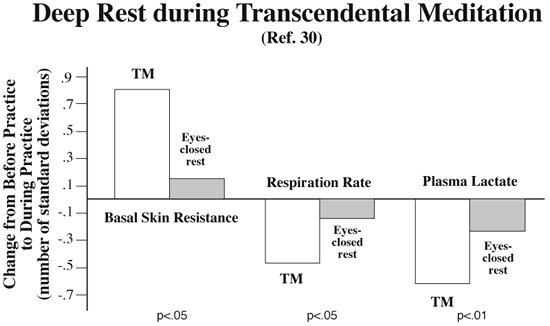
REDUCED REQUIREMENTS FOR HEALTH CARE
The most important contribution of Transcendental Meditation to health would appear to be in primary prevention. Research from the USA examined health-care utilization over five consecutive years among 2,000 people practising Transcendental Meditation, as compared to control groups (from a total sample of 600,000) who were closely comparable with regard to age, gender, occupation, and health insurance terms [2]. Over the five-year period, the Transcendental Meditation participants consistently had fewer than half the number of doctor visits and days in hospital compared to controls. Of considerable interest was the fact that the Transcendental Meditation group showed relatively little increase in need for health care with increasing age, whereas this trend was clearly seen in controls, as would usually be expected (see chart below).
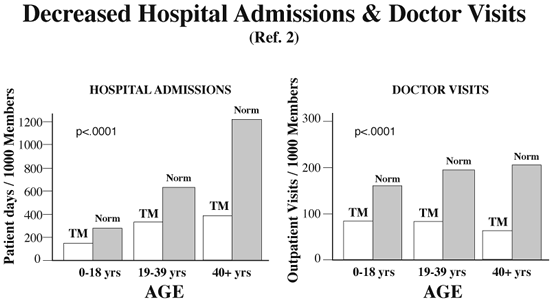
Hospital admission rates for medical and surgical conditions were 60-70% lower in the Transcendental Meditation group, with reductions in all 17 disease categories studied. For example, hospital admissions were 87% less for diseases of the heart and blood vessels, 55% less for tumours, 73% less for respiratory disorders, 87% less for neurological problems, and 30% less for infections (see chart below).
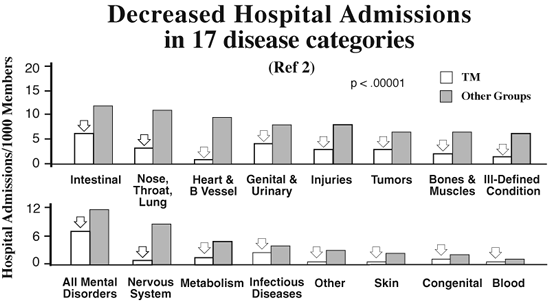
These results are supported by further research showing reduced medical costs among individuals practising Transcendental Meditation [45] and even greater reduction in needs for health care when the technique is supplemented by other aspects of Maharishi’s Vedic Approach to Health [46] (please refer to Part II: Scientific Research on Maharishi Ayur-Veda).
Other studies have reported decreased requirements for medication among people who practise Transcendental Meditation, including reduced use of mild analgesics, sleeping tablets, tranquillisers, anti-depressants, anti-histamines, asthma inhalers, anti-hypertensives, and drugs for heart disease [47-51].
REDUCTION OF MAJOR RISK FACTORS FOR DISEASE
Reduced requirements for health care are consistent with research showing that Transcendental Meditation reduces a variety of important risk factors for disease, including coronary heart disease and cancer [52]. These findings include reductions in: high blood pressure [53-61]; elevated cholesterol levels [55, 62]; cigarette smoking, alcohol consumption, and drug abuse [47, 63-67]; overweight [68]; cardiovascular reactivity to stress [69]; physiological and psychological stress levels [30, 70-74]; anxiety, depression, and hostility [65, 71, 75-77]. Transcendental Meditation also enhances potential protective factors such as job satisfaction [72, 78] and overall psychological health and well-being [79].
REDUCTION IN HIGH BLOOD PRESSURE
A number of studies have shown that Transcendental Meditation leads to clinically beneficial reductions in blood pressure [53-58, 60, 61]. Randomized controlled trials have found that Transcendental Meditation is significantly more effective in reducing mild high blood pressure than any of the following: a relaxation technique (progressive muscular relaxation), a pseudo-meditation procedure (which attempted to imitate the Transcendental Meditation technique), or a ‘usual care’ programme comprising advice on weight loss, salt restriction, exercise, and reduced alcohol intake [57, 60, 61] (see chart below).
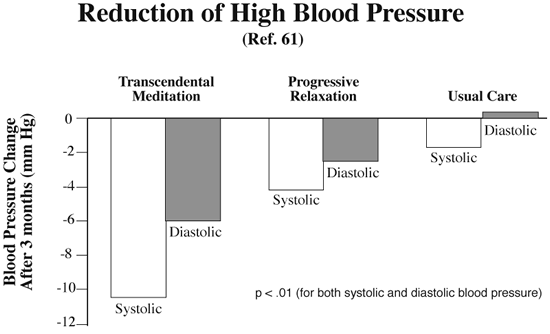
Transcendental Meditation produced reductions in systolic and diastolic pressure comparable to those commonly found with anti-hypertensive medication, but without any adverse side effects [60].
Further analysis showed that Transcendental Meditation produced significant reductions in systolic and diastolic blood pressure for men and women in both high- and low-risk groups on six measures of hypertension risk: psychosocial stress, obesity, alcohol use, physical inactivity, dietary sodium-potassium ratio, and a composite measure of these risk factors [61].
Non-pharmacological methods are now recognized as crucial to therapy for hypertension, especially in patients under 60 years. For example, the United States Joint National Committee on the Detection, Evaluation, and Treatment of High Blood Pressure has recommended that non-pharmacological, behavioural approaches ‘should be used both as definitive intervention and as an adjunct to pharmacologic therapy and should be considered for all anti-hypertensive therapy’ [80].
A review of research on behavioural therapy for hypertension [58] concluded that Transcendental Meditation provides an optimal non-pharmacological treatment and preventive programme for high blood pressure because the technique:
- produces rapid, clinically significant blood pressure reductions;
- is distinctly more effective than other meditation and relaxation procedures;
- is continued by a high proportion of subjects (in contrast to lower continuation rates for relaxation techniques and the frequent problem of poor compliance with anti-hypertensive drugs);
- has documented acceptability and effectiveness in a wide range of populations;
- is effective in reducing high blood pressure both when used as sole treatment and when used in concert with medication;
- reduces high blood pressure in ‘real life’ environments outside the clinic;
- is free from harmful side-effects or adverse reactions;
- also reduces other cardiovascular risk factors and improves health in a general way.
In addition, a recent analysis found that Transcendental Meditation is more cost-effective in treating mild hypertension than medication [81].
BENEFITS FOR MENTAL HEALTH
A large body of research has demonstrated that Transcendental Meditation produces comprehensive improvements in mental health, enhancing positive features and reducing various forms of psychological distress [48, 49, 65, 71, 72, 74-79, 82-104].
A systematic review of 144 studies found that Transcendental Meditation was markedly more effective in reducing anxiety than other techniques (including progressive muscular relaxation, methods claimed to induce a ‘relaxation response’, and other forms of meditation) [76]. The superiority of Transcendental Meditation remained highly significant when only the strongest and most rigorous studies were included in the analysis. Transcendental Meditation has also consistently been found to reduce depression, hostility, and emotional instability, indicating the growth of a more stable, balanced, and resilient personality [65, 71, 74, 75, 77, 82, 86, 87, 92, 101].
In another statistical review of 42 independent research results, Transcendental Meditation was found to be three times as effective as other meditation and relaxation procedures in increasing self-actualization—an overall measure of positive mental health and personal development. Further analysis revealed that the technique is exceptionally effective in developing three independent components of this dimension: emotional maturity, a resilient sense of self, and a positive, integrated perspective on ourselves and the world [79].
An exhaustive survey conducted by the Swedish National Health Board found evidence that psychiatric hospital admissions may be much less common among people practising Transcendental Meditation than in the general population. This study also strongly confirmed Transcendental Meditation’s excellent safety record [95].
EFFECTIVE RELIEF FROM STRESS: TREATING THE WHOLE PERSON
The comprehensive nature of Transcendental Meditation's benefits for mental health is well illustrated in a randomized study of Vietnam War veterans suffering from post-traumatic stress disorder—a common and extremely distressing syndrome which can result from many causes and is often difficult to treat [71] (see chart below).
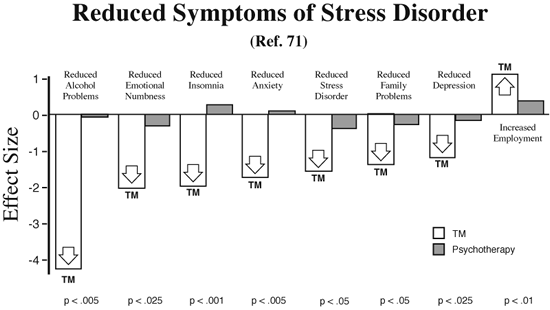
Over a three-month period, patients practising Transcendental Meditation showed clear-cut improvements in all aspects of the syndrome studied, with significant decreases in depression, anxiety, insomnia, and alcohol consumption, improvement in family problems, reduced severity of delayed stress syndrome and less emotional numbness, as well as greater ease in obtaining a job. By contrast, the control group who received standard treatment with psychotherapy showed no significant change on any measure.
REDUCED USE OF CIGARETTES, ALCOHOL & NON-PRESCRIBED DRUGS
Transcendental Meditation has been found to lead to reduced use of alcohol, cigarettes, and non-prescribed drugs [47, 48, 63-66, 71, 72, 96, 97, 105-120]. A statistical meta-analysis summarising 19 studies on the effects of Transcendental Meditation found the technique produced substantial and highly significant reductions in alcohol, cigarettes and illicit drug use, with larger effects than other treatments, including standard therapies and other techniques of meditation and relaxation [64]. Over an 18-24 month period, abstinence ranged from 51% to 89% for Transcendental Meditation compared to 21% for good conventional substance abuse programmes (see chart below).
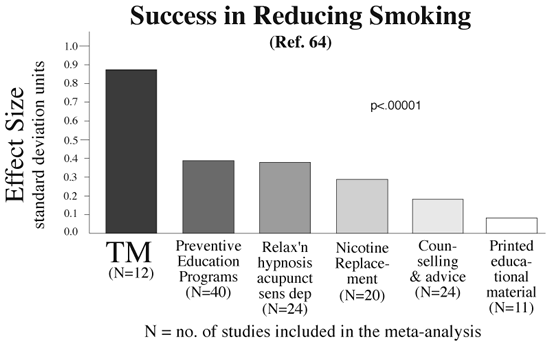
Readers interested in finding out more about this subject are referred to a book Self-Recovery: Treating Addictions Using Transcendental Meditation and Maharishi Ayur-Veda (Haworth Press, 1994), which reprints papers 64-66, 96, 97, 111-120.
REDUCING MEDICAL EXPENDITURE
Transcendental Meditation has also been shown to have a direct effect on reducing medical expenditure. A study using government health statistics in Quebec analysed the medical expenses of 677 people practising Transcendental Meditation for three years before and up to seven years after learning the technique. Monthly data on payments to physicians for treatment under the provincial health insurance scheme were adjusted to account for ageing, inflation, and other influences, using normative data provided by the Quebec government. After commencing Transcendental Meditation, real expenses declined 5 to 7 per cent annually over the seven year follow-up period [45].
These results are supported by a recent study showing a 57 per cent reduction in medical expenditure in subjects practising Transcendental Meditation and other aspects Maharishi’s Vedic Approach to Health [46] (see Part II: Scientific Research on Maharishi Ayur-Veda). As mentioned above, Transcendental Meditation has been found to be more cost-effective than medication in treating mild hypertension [81].
TRANSCENDENTAL MEDITATION AND COMMON DISORDERS
In Britain and other countries, many doctors have been encouraging patients to learn Transcendental Meditation [121, 122]. Based on research and clinical experience, a number of authors have examined the role of Transcendental Meditation in the management of common clinical problems—including reduction of risk factors for disease, mild hypertension, stress-related disorders, migraine, anxiety, mild depression, and substance misuse—and have explored its contribution to the promotion of positive health and well-being, and the enhancement of quality of life for patients with serious disorders [49, 52, 58, 64-66, 75, 97, 113-130].
In a controlled study on asthma, Transcendental Meditation was found to improve airway resistance and to reduce severity of symptoms (as evaluated by both patients and physicians) [124].
A controlled study examined the effect of Transcendental Meditation on exercise tolerance in patients with angina pectoris (chest pain on exercise due to heart disease). All patients in this study had proven coronary artery disease, mostly of moderate or severe degree, and positive exercise-stress tests, indicating inadequate blood flow to the heart muscle during exercise.
Over an eight-month period, subjects who practised Transcendental Meditation showed significant improvements in exercise tolerance and maximum work load achieved during a standard exercise test. In addition, exercise could be continued for longer before signs of oxygen shortage in the heart muscle appeared in the ECG (electrocardiogram), indicating improved oxygenation of the heart muscle. Nine out of ten subjects practising Transcendental Meditation showed improved exercise tolerance, while no improvements were observed in a control group [125].
A number of studies have reported reduced insomnia and improved quality of sleep as a result of Transcendental Meditation [48, 67, 71, 72, 77, 101]. There is also evidence that subjects practising this technique have better periodontal health [131].
TRANSCENDENTAL MEDITATION AND OTHER TECHNIQUES
Transcendental Meditation is unique in the range and depth of research into its effects. Controlled studies comparing Transcendental Meditation with various other methods of relaxation or meditation have demonstrated the distinct effectiveness of the technique in promoting deep physiological rest, reducing stress, decreasing mild high blood pressure, improving mental health, and enhancing perceptual-motor performance [9, 24, 30, 57, 58, 76, 79, 91, 92, 132].
As discussed above, systematic reviews employing the technique of meta-analysis—the preferred statistical method for comparing data from a wide variety of sources—have shown that Transcendental Meditation is markedly more effective than relaxation techniques and other forms of meditation in reducing anxiety, improving overall psychological health, and reducing substance abuse [64, 76, 79] (see chart below).
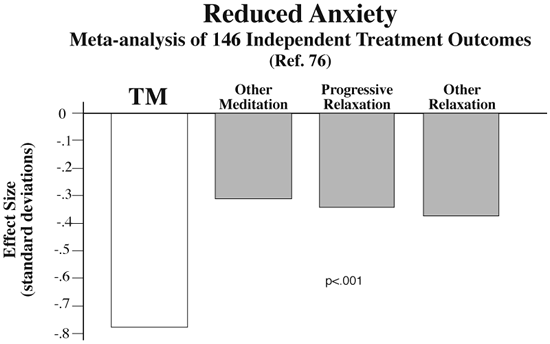
A meticulously controlled, randomised study conducted at Harvard University found that elderly individuals who learned Transcendental Meditation showed significantly greater improvements in a variety of age-related aspects of mental and physical health and well-being than subjects taught other techniques or a no-treatment control group. In particular, those who learned a relaxation procedure that attempted to imitate Transcendental Meditation showed no improvement on any measure. A clear majority of subjects practising Transcendental Meditation rated their technique as personally useful and easy to practise in contrast to lower rates for the other techniques. Most strikingly, after three years, all those who had learned Transcendental Meditation were still living in contrast to significantly lower survival rates for the other three groups and for the remaining inhabitants of the institutions where the study was conducted [57] (see chart below).
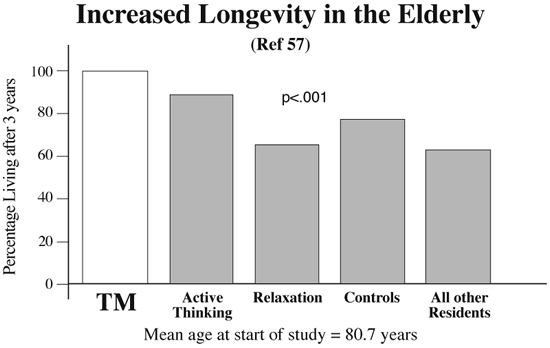
POSITIVE HEALTH
The effects of Transcendental Meditation go beyond prevention and treatment towards the development of positive aspects of health. This development is illustrated by studies showing: increased creativity and intelligence [86, 133-135]; improvements in perceptual acuity [136-140], mind-body co-ordination [132, 141, 142], and spinal reflex efficiency [143, 144]; improvements in academic performance, greater moral maturity, increased orientation towards positive values, and growth of social maturity in college students [98, 145-147]; better relationships at work [72, 78]; and increased marital satisfaction and adjustment [94].
REVERSAL OF THE DELETERIOUS EFFECTS OF THE AGEING PROCESS
It has been noted that many effects of Transcendental Meditation are opposite to deteriorations usually seen with ageing [1, 57, 135, 148-151], while others indicate a strengthening of factors known to favour longevity and good health in later life (such as cardiovascular health, work satisfaction, positive health habits, mental health, happiness, and intelligence) [57, 148].
In keeping with these observations, a study employing a standardized ageing index found that the biological age of middle-aged individuals practising Transcendental Meditation was significantly younger than both their chronological age and the biological age of non-meditating control subjects. The longer subjects had been practising Transcendental Meditation, the greater was the degree to which biological age was younger than chronological age [148].
As discussed above, a randomized controlled study on elderly individuals found that Transcendental Meditation led to improvements in mental and physical health and well-being, cognitive and perceptual abilities, and longevity [57].
Compared to controls, middle-aged and older individuals practising Transcendental Meditation have been found to maintain higher levels of dehydroepiandrosterone sulfate (DHEA-s), a hormone which declines steadily throughout adult life. Low levels of DHEA-s have been linked with a variety of diseases and with increased mortality. On average, DHEA-s levels in people practising Transcendental Meditation were comparable to levels of non-meditators who were 5-10 years younger—a difference that could not be explained by variations in diet, weight, or exercise habits [150].
Subjects practising Transcendental Meditation have also been found to have lower average erythrocyte sedimentation rate (ESR) and a higher frequency of zero ESR compared to controls. Increased ESR correlates with ageing and is a well-established indicator of disease [151].
Increased need for health care is one of the most important and obvious correlates of ageing. As mentioned above, an American study of health insurance data found relatively little increase in health care needs with advancing age among individuals practising Transcendental Meditation, in contrast to a marked increase seen in a normative control group [2]. Similar results were found in a recent investigation of health care utilisation in people practising Transcendental Meditation and other aspects of Maharishi’s Vedic Approach to Health [46] (see Scientific Research on Maharishi Ayur-Veda).
OCCUPATIONAL HEALTH
Transcendental Meditation can be valuable for occupational health and performance [67, 72, 74, 78, 152]. One study examined stress, health, and employee development in two settings in the automotive industry: a large manufacturing plant of a Fortune 100 corporation and a small sales distribution company. Employees who learned Transcendental Meditation showed significantly greater improvement than matched control subjects on a wide variety of measures, including: reduced physiological arousal; decreases in anxiety, job tension, insomnia and fatigue; reduced consumption of cigarettes and hard liquor; and improved general health [72]. Practice of Transcendental Meditation also led to increased job satisfaction, improved employee effectiveness, and better relationships, confirming the findings of earlier studies [78].
In a five-month study conducted by researchers from Japan's National Institute of Industrial Health (a branch of the Japanese Ministry of Labour), industrial employees practising Transcendental Meditation showed increased emotional stability, reduced anxiety, decreased tendency to neurosis, reduced impulsiveness, decreased physical complaints, and reduced insomnia and smoking compared to controls. Depression was also reduced in the Transcendental Meditation group, despite lower initial levels [67, 74]. Overall, employees practising Transcendental Meditation improved significantly on 10 out of 14 mental health scales, whereas controls improved on only one [74].
Development of a company's human resources through Transcendental Meditation has been shown to produce marked improvements in corporate health and performance. For example, in a medium-sized chemical manufacturing company, productivity and profitability increased steadily as the number of employees practising Transcendental Meditation rose over a six-year period to 80 per cent of the total workforce. Over this time period productivity increased by 52 per cent, annual sales per employee grew by 88 per cent, while days lost through illness or injury decreased by 50 per cent and absenteeism declined by 89 per cent [152].
REHABILITATION OF CRIMINAL OFFENDERS
Transcendental Meditation has been applied very successfully in the rehabilitation of criminal offenders. Studies have shown a wide variety of improvements in mental health and behaviour in prison inmates, and substantially reduced rates of recidivism [77, 101-104].
COLLECTIVE HEALTH
Individual health cannot be divorced from the collective health of society. More than 40 well-controlled studies have now shown that about 1% of the population of a community practising Transcendental Meditation, or an even smaller fraction practising the advanced TM-Sidhi programme, can lead to reduction of negative tendencies (such as violence, crime, accidents, disease, and suicides) and improvement in positive trends (such as economic prosperity) for the whole society [153-165] (see chart below).
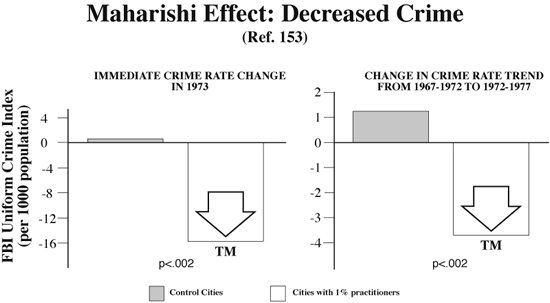
Researchers have named this phenomenon the Maharishi Effect, as it was predicted by Maharishi in 1960. Decreased crime rate in the Merseyside region has been demonstrated as a result of this effect [165].
Reduction in crime and other improvements in the quality of life in society have direct benefits for the individual by reducing collective stress and social disharmony, both of which are known to be major factors influencing health standards in the general population.
